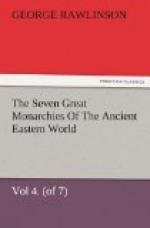APPENDIX.
A. STANDARD INSCRIPTION OF NEBUCHADNEZZAR.
The Inscription begins with the various titles of Nebuchadnezzar. It then contains prayers and invocations to the Gods, Merodach and Nebo. The extent of N.’s power is spoken of—it reaches from one sea to the other.
An account is then given of the wonders of Babylon, viz.:
1. The great temple of Merodach. (The mound of Babil is the tower or ziggurat of this.)
2. The Borsippa temple (or Birs).
3. Various other temples in Babylon and Borsippa.
The subjoined description of the city follows: “The double inclosure which Nabopolassar my father had made but not completed, I finished. Nabopolassar made its ditch. With two long embankments of brick and mortar he bound its bed. He made the embankment of the Arahha. He lined the other side of the Euphrates with brick. He made a bridge (?) over the Euphrates, but did not finish its buttresses (?). From... (the name of a place) he made with bricks burnt as hard as stones, by the help of the great Lord Merodach, a way (for) a branch of the Shimat to the waters of the Yapur-Shapu, the great reservoir of Babylon, opposite to the gate of Nin.
“The Ingur-Bel and the Nimiti-Bel—the great double wall of Babylon—I finished. With two long embankments of brick and mortar I built the sides of its ditch. I joined it on with that which my father had made. I strengthened the city. Across the river to the west I built the wall of Babylon with brick. The Yapur-Shapu-the reservoir of Babylon—by the grace of Merodach I filled completely full of water. With bricks burnt as hard as stones, and with bricks in huge masses like mountains (?), the Yapur-Shapu, from the gate of Mula as far as Nana, who is the protectress of her votaries, by the grace of his godship (i.e. Merodach) I strengthened. With that which my father had made I joined it. I made the way of Nana, the protectress of her votaries. The great gates of the Ingur-Bel and the Nimiti-Bel-the reservoir of Babylon, at the time of the flood (lit. of fulness), inundated them. These gates I raised. Against the waters their foundations with brick and mortar I built. [Here follows a description of the gates, with various architectural details, an account of the decorations, hangings, etc.] For the delight of mankind I filled the reservoir. Behold! besides the Ingur-Bel, the impregnable fortification of Babylon.




